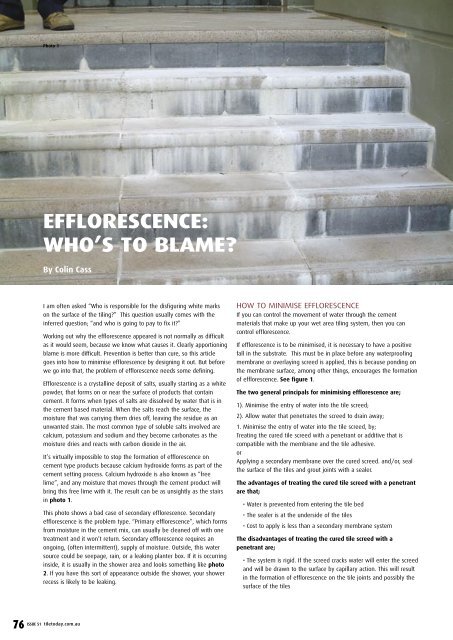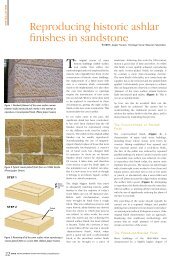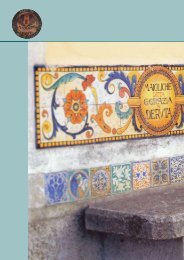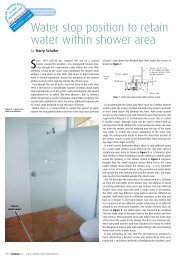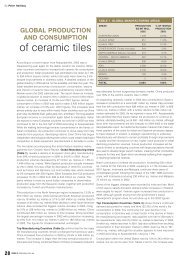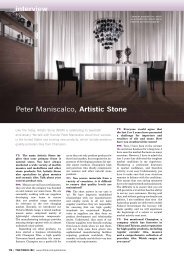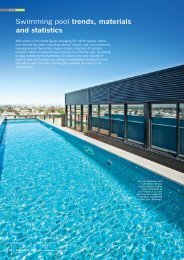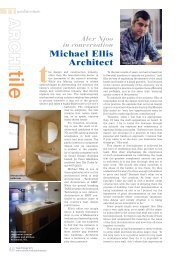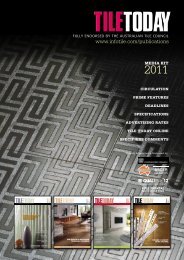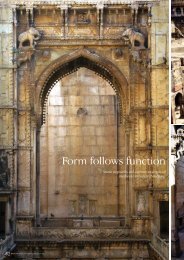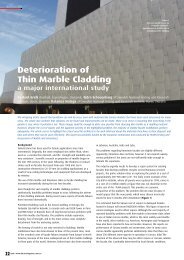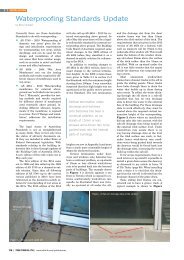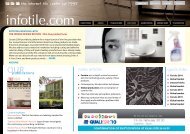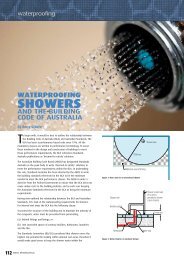Efflorescence by Colin Cass.indd - Infotile
Efflorescence by Colin Cass.indd - Infotile
Efflorescence by Colin Cass.indd - Infotile
You also want an ePaper? Increase the reach of your titles
YUMPU automatically turns print PDFs into web optimized ePapers that Google loves.
Photo 1EFFLORESCENCE:WHO’S TO BLAME?By <strong>Colin</strong> <strong>Cass</strong>I am often asked “Who is responsible for the disfiguring white markson the surface of the tiling?” This question usually comes with theinferred question; “and who is going to pay to fix it?”Working out why the efflorescence appeared is not normally as difficultas it would seem, because we know what causes it. Clearly apportioningblame is more difficult. Prevention is better than cure, so this articlegoes into how to minimise efflorescence <strong>by</strong> designing it out. But beforewe go into that, the problem of efflorescence needs some defining.<strong>Efflorescence</strong> is a crystalline deposit of salts, usually starting as a whitepowder, that forms on or near the surface of products that containcement. It forms when types of salts are dissolved <strong>by</strong> water that is inthe cement based material. When the salts reach the surface, themoisture that was carrying them dries off, leaving the residue as anunwanted stain. The most common type of soluble salts involved arecalcium, potassium and sodium and they become carbonates as themoisture dries and reacts with carbon dioxide in the air.It’s virtually impossible to stop the formation of efflorescence oncement type products because calcium hydroxide forms as part of thecement setting process. Calcium hydroxide is also known as “freelime”, and any moisture that moves through the cement product willbring this free lime with it. The result can be as unsightly as the stairsin photo 1.This photo shows a bad case of secondary efflorescence. Secondaryefflorescence is the problem type. “Primary efflorescence”, which formsfrom moisture in the cement mix, can usually be cleaned off with onetreatment and it won’t return. Secondary efflorescence requires anongoing, (often intermittent), supply of moisture. Outside, this watersource could be seepage, rain, or a leaking planter box. If it is occurringinside, it is usually in the shower area and looks something like photo2. If you have this sort of appearance outside the shower, your showerrecess is likely to be leaking.HOW TO MINIMISE EFFLORESCENCEIf you can control the movement of water through the cementmaterials that make up your wet area tiling system, then you cancontrol efflorescence.If efflorescence is to be minimised, it is necessary to have a positivefall in the substrate. This must be in place before any waterproofingmembrane or overlaying screed is applied, this is because ponding onthe membrane surface, among other things, encourages the formationof efflorescence. See figure 1.The two general principals for minimising efflorescence are;1). Minimise the entry of water into the tile screed;2). Allow water that penetrates the screed to drain away;1. Minimise the entry of water into the tile screed, <strong>by</strong>;Treating the cured tile screed with a penetrant or additive that iscompatible with the membrane and the tile adhesive.orApplying a secondary membrane over the cured screed. and/or, sealthe surface of the tiles and grout joints with a sealer.The advantages of treating the cured tile screed with a penetrantare that;• Water is prevented from entering the tile bed• The sealer is at the underside of the tiles• Cost to apply is less than a secondary membrane systemThe disadvantages of treating the cured tile screed with apenetrant are;• The system is rigid. If the screed cracks water will enter the screedand will be drawn to the surface <strong>by</strong> capillary action. This will resultin the formation of efflorescence on the tile joints and possibly thesurface of the tilesISSUE 51 tiletoday.com.au76
photo 2 & 3LevelSaturatedScreedFigure 1: The moisture in a saturated screed will move upwards towards the warmth and bring the salts with it. The salts then depositthemselves on the surface, usually in the form of crusty tile joints. This system is very common. It is to be avoided if possible, especiallyon balconies and decks.Figure 2: Alternative Waterproofing SystemsReinforcingBondedToppingScreedMembrane acts as a slip sheet, therefore a reinforcedscreed is required. Some efflorescence could still occur.Suitable for all membranesMembraneWaterproofing membrane on top of screed as well as onsubstrate. Expensive and slow but efflorescence isvirtually impossible. Screed must be reinforced over sheetflooring. Not suitable for solvent PU membranes.• The process will slow up the tiling process due to the curing timerequired for the screed and the penetrant• Some of the chemicals used as penetrants may react with the tileadhesive and the membrane• Wet bed fixing of tiles cannot be used with this method.The advantages of applying a secondary membrane over the curedscreed, as seen in figure 2 are;• It excludes moisture from the tile screed• There is a better ability to withstand movementThe disadvantages of applying a secondary membrane over thecured screed;• Double membrane means double cost• The process will slow up the tiling process because the screed hasISSUE 51 tiletoday.com.au78
to be cured before the membrane is applied.• Bond breaker / fillet joints in the secondary membrane at thewall/floor junction may interfere with the tiling process• Some of the chemicals used may not be compatible with the tileadhesive and the membrane. Note: because tile adhesive bondingissues, solvent based polyurethane membranes are NOT to be usedas a secondary membrane systemThe advantages of sealing the surface of the tiles and grout joints witha sealer are;• It does not delay the tiling process• It is possible to wet bed tiles• It makes the tile and grout more stain resistantThe disadvantages of sealing the surface of the tiles and grout jointswith a sealer;• Minor cracks in the grouting will lead to water penetration• Water will bead on the surface which may lessen the slipresistance of the surface finish• The surface sealer will require periodical re-application• This system should not be relied upon as the sole method ofminimizing efflorescence.2. Allow water that penetrates the screed to drain;This system relies on draining any water that penetrates the tile screedto a designated outlet.It is a primary requirement of this method of controlling efflorescenceto have positive fall in the substrate before any overlaying screed isapplied.This system should not drain to a free edge unless the salt laden wateris collected <strong>by</strong> a gutter, or unless the area is not going to be adverselyaffected <strong>by</strong> the appearance of efflorescence. (eg a garden bed)Consideration should be given to installing water stop angles at freeedges and behind the nosing at the top of stairs; however, this meansthere must be positive fall in the substrate from the water stop to thedrainage outlet. The drainage outlet must be designed to allowsoluble salts to enter the drainage system at the neck of the grate.If efflorescence is thought likely to be a problem, it is good practice tocombine the precautions of principles 1 and 2 above.The NSW Master Builder Waterproofing Committee (www.mbansw.asn.au) has just published a good guide to waterproofing both internal andexternal wet areas, it incorporates these details of how to minimiseefflorescence.CONCLUSIONIt has long been argued that efflorescence is a “building maintenance”issue and not a building defect, but this can be called into questionbecause efflorescence can be almost entirely designed out.The key factors to success at minimising efflorescence are having fallsin the substrate combined with restricting the entrance of moistureinto the tiling bed.So tilers, if you are asked to screed over a substrate with a negativefall, you would be well advised to have one of the above systemsused, otherwise efflorescence will almost certainly form.<strong>Colin</strong> <strong>Cass</strong> can be contacted at colin@cass.orgThanks to Hank Riedstra, the NSW MBA and the Cement and ConcreteAssociation of New ZealandMOVEMENT JOINT SOLUTIONS FOR INDUSTRIAL / COMMERCIAL / RESIDENTIALThe Original Neoprene-X-Pansion® LocStrips, Tile Strips & Expansion Joint CoversLatham Terrazzo, Stone & Tile Control Stripswww.latham-australia.comLatham Type CA-25VFloor Joint CoverContact Latham Australia for full product detailsPhone: 02 9879 7888 • Fax: 02 9879 7666 • Email: joints@latham-australia.com


